Into the Woods | reviews, news & interviews
Into the Woods
Into the Woods
Big-screen Sondheim adaptation is witty and shrewd, but sinister in the wrong place
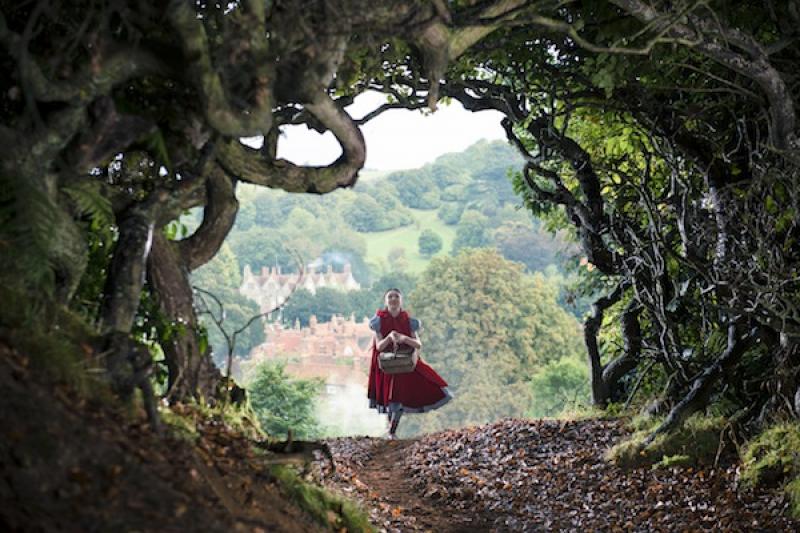
Woods and forests were given a fresh impetus as a psychic terrain for the cinema by Lothlórien, Fangorn, and the other sylvan spaces so ethereally or threateningly rendered in The Lord of the Rings films and, to a lesser extent, by the Mirkwood of the second Hobbit movie.
The Into the Woods woods don't set the pulse racing the same way. Although the dense, dark thickets designed by Dennis Gassner and filmed on a Shepperton soundstage physically reflect the influence of Arthur Rackham’s peerless fairy tale illustrations, they lack their eldritch malice. The wild woods that engulf the 1937 Snow White and The Wind in the Willows’ Mole (on the page) are much more terrifying. (Pictured below: Meryl Streep as the Witch.)
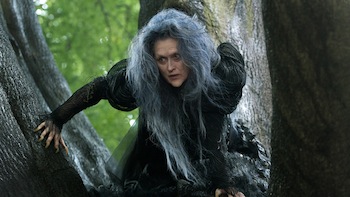 “I wanted [everyone] to feel…slightly scared,” Gassner told the Los Angeles Times. Instilling dread in the audience would have been undesirable, of course, for Chicago director Rob Marshall’s movie of Stephen Sondheim’s 1986 fairy tale mash-up musical, adapted by James Lapine (who wrote the original book) and predicated as a safe family entertainment for the holidays.
“I wanted [everyone] to feel…slightly scared,” Gassner told the Los Angeles Times. Instilling dread in the audience would have been undesirable, of course, for Chicago director Rob Marshall’s movie of Stephen Sondheim’s 1986 fairy tale mash-up musical, adapted by James Lapine (who wrote the original book) and predicated as a safe family entertainment for the holidays.
It feels like a missed opportunity. But what Into the Woods misses in creepiness, it makes up for in wit. It's at its best when Sondheim’s artful lyrics parody the self-regarding earnestness expressed in many Broadway songs and Disney’s unctuous animated princess tales especially. It does this with more shrewdness and class than Enchanted and less smugness than the Shrek movies.
The bravura opening sequence – the 14-minute song “Prologue: Into the Woods” is a marvel of cross-cutting – sends the usual suspects under the branches on dedicated missions: Cinderella (the always game Anna Kendrick) to attend the King's festival and find her Prince (Chris Pine); Little Red Riding Hood (Lilla Crawford) to visit Granny; Jack (Daniel Huttlestone) to sell his milkless milk cow at the behest of his careworn mother (Tracey Ullman, excellent); and the Baker (James Corden) and his wife (Emily Blunt) to remove the curse placed on their fertility by the Witch (Meryl Streep), who, a potion in mind, has tasked them with finding "One: the cow as white as milk/Two: the cape as red as blood/Three: the hair as yellow as corn/Four: the slipper as pure as gold.” (This clueless married pair was originated by Sondheim and Lapine.)
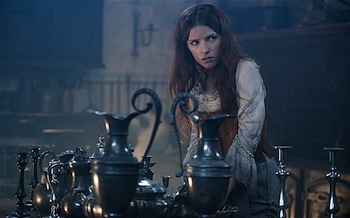 Ebulliently but not scarily portrayed by Streep, the redeemable witch herself heads wood-wards to see her sequestered adopted daughter, Rapunzel (Mackenzie Mauzy, more Baby Spice than Rackham waif). In the film’s funniest scene, Rapunzel’s prince (Billy Magnussen) and Cinderella’s prince duet on “Agony” atop a waterfall, their perfect grooming and faux macho posturing suggesting they ought to settle down together rather than pursue a pushy scullery maid (Kendrick as Cinderella, pictured above) and a vapid prisoner with unmanageable hair. Red is more streetwise, a brat whose casual pilfering from the bakery raises the spectre of high-street shoplifting. Twenty-odd years ago, she might have been played by Christina Ricci in what could have been a subversive Tim Burton version, but the droll Crawford makes Red less acerbic than Ricci would have done.
Ebulliently but not scarily portrayed by Streep, the redeemable witch herself heads wood-wards to see her sequestered adopted daughter, Rapunzel (Mackenzie Mauzy, more Baby Spice than Rackham waif). In the film’s funniest scene, Rapunzel’s prince (Billy Magnussen) and Cinderella’s prince duet on “Agony” atop a waterfall, their perfect grooming and faux macho posturing suggesting they ought to settle down together rather than pursue a pushy scullery maid (Kendrick as Cinderella, pictured above) and a vapid prisoner with unmanageable hair. Red is more streetwise, a brat whose casual pilfering from the bakery raises the spectre of high-street shoplifting. Twenty-odd years ago, she might have been played by Christina Ricci in what could have been a subversive Tim Burton version, but the droll Crawford makes Red less acerbic than Ricci would have done.
Corden’s diffident Everybloke narrates the story (rather than the musical’s Mysterious Man), Blunt’s romantically conflicted wife steals it. “Is it always ‘or?/Is it never ‘and’?”, she sings plaintively in “Moments in the Woods”. The Baker has discovered his latent manliness too late. The couple (Blunt and Corden, pictured below) takes center stage in the second act, but it’s so tediously convoluted that it sags like a rope bridge weighed down by a Laurel and Hardy-borne piano. A leaner narrative might have emphasized Sondheim and Lapine’s “be careful what you wish for” morality theme. Having achieved their goals under the woods' dangerously liberating influence, and got more than they bargained for, the five seekers must question and reverse their choices.
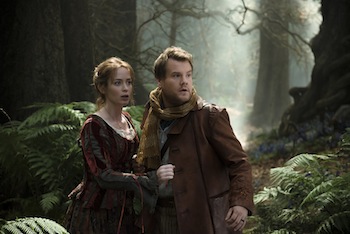 Jack, for example, is beset by giants in the land above his beanstalk, presented by Sondheim as a symbol of a pubescent youth’s sexual hubris and, when growing rapidly in “A Very Nice Prince”, as an object of interest for Cinderella. She doesn’t anticipate the pitfalls of falling for a rake, however, and must escape her new husband, who tells her, “I was raised to be charming, not sincere". The five don’t all make it out alive, for Into the Woods is not overtly sentimental. No prizes for guessing which one of them dies and why.
Jack, for example, is beset by giants in the land above his beanstalk, presented by Sondheim as a symbol of a pubescent youth’s sexual hubris and, when growing rapidly in “A Very Nice Prince”, as an object of interest for Cinderella. She doesn’t anticipate the pitfalls of falling for a rake, however, and must escape her new husband, who tells her, “I was raised to be charming, not sincere". The five don’t all make it out alive, for Into the Woods is not overtly sentimental. No prizes for guessing which one of them dies and why.
There was constant speculation during the film's long gestation that its killings and sexual content would be eliminated. In the end, there was a softening of these elements, if not a ruthless bowdlerization. Sondheim purists are more likely to regret the cutting of 10 songs (including two reprises), though the tunes of two of them were incorporated.
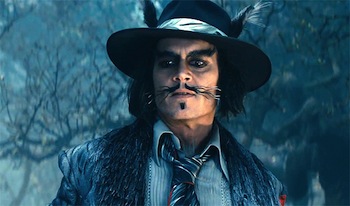 One nasty bit of business did slip through the net. Johnny Depp, stereotypically cast as the Wolf (pictured left), serenades Red with the prospect of her being devoured. Little kids will think this means “eaten”, but Depp’s arch lewdness suggests otherwise. Some abuse occurs off screen, but it’s short of statutory rape. “Isn't it nice to know a lot!/And a little bit not...” Red sings afterwards. Lilla Crawford is 13. Sarah Patterson was reportedly the same age when she played Rosaleen in Neil Jordan’s The Company of Wolves (1984), the best Red Riding Hood movie, but writer Angela Carter made it clear that the lycanthropic Huntsman (Micha Bergese) is a potential ravisher in a dream.
One nasty bit of business did slip through the net. Johnny Depp, stereotypically cast as the Wolf (pictured left), serenades Red with the prospect of her being devoured. Little kids will think this means “eaten”, but Depp’s arch lewdness suggests otherwise. Some abuse occurs off screen, but it’s short of statutory rape. “Isn't it nice to know a lot!/And a little bit not...” Red sings afterwards. Lilla Crawford is 13. Sarah Patterson was reportedly the same age when she played Rosaleen in Neil Jordan’s The Company of Wolves (1984), the best Red Riding Hood movie, but writer Angela Carter made it clear that the lycanthropic Huntsman (Micha Bergese) is a potential ravisher in a dream.
Add comment
The future of Arts Journalism
You can stop theartsdesk.com closing!
We urgently need financing to survive. Our fundraising drive has thus far raised £49,000 but we need to reach £100,000 or we will be forced to close. Please contribute here: https://gofund.me/c3f6033d
And if you can forward this information to anyone who might assist, we’d be grateful.

Subscribe to theartsdesk.com
Thank you for continuing to read our work on theartsdesk.com. For unlimited access to every article in its entirety, including our archive of more than 15,000 pieces, we're asking for £5 per month or £40 per year. We feel it's a very good deal, and hope you do too.
To take a subscription now simply click here.
And if you're looking for that extra gift for a friend or family member, why not treat them to a theartsdesk.com gift subscription?
more Film
 The Mastermind review - another slim but nourishing slice of Americana from Kelly Reichardt
Josh O'Connor is perfect casting as a cocky middle-class American adrift in the 1970s
The Mastermind review - another slim but nourishing slice of Americana from Kelly Reichardt
Josh O'Connor is perfect casting as a cocky middle-class American adrift in the 1970s
 Springsteen: Deliver Me From Nowhere review - the story of the Boss who isn't boss of his own head
A brooding trip on the Bruce Springsteen highway of hard knocks
Springsteen: Deliver Me From Nowhere review - the story of the Boss who isn't boss of his own head
A brooding trip on the Bruce Springsteen highway of hard knocks
 The Perfect Neighbor, Netflix review - Florida found-footage documentary is a harrowing watch
Sundance winner chronicles a death that should have been prevented
The Perfect Neighbor, Netflix review - Florida found-footage documentary is a harrowing watch
Sundance winner chronicles a death that should have been prevented
 Blu-ray: Le Quai des Brumes
Love twinkles in the gloom of Marcel Carné’s fogbound French poetic realist classic
Blu-ray: Le Quai des Brumes
Love twinkles in the gloom of Marcel Carné’s fogbound French poetic realist classic
 Frankenstein review - the Prometheus of the charnel house
Guillermo del Toro is fitfully inspired, but often lost in long-held ambitions
Frankenstein review - the Prometheus of the charnel house
Guillermo del Toro is fitfully inspired, but often lost in long-held ambitions
 London Film Festival 2025 - a Korean masterclass in black comedy and a Camus classic effectively realised
New films from Park Chan-wook, Gianfranco Rosi, François Ozon, Ildikó Enyedi and more
London Film Festival 2025 - a Korean masterclass in black comedy and a Camus classic effectively realised
New films from Park Chan-wook, Gianfranco Rosi, François Ozon, Ildikó Enyedi and more
 After the Hunt review - muddled #MeToo provocation
Julia Roberts excels despite misfiring drama
After the Hunt review - muddled #MeToo provocation
Julia Roberts excels despite misfiring drama
 London Film Festival 2025 - Bradley Cooper channels John Bishop, the Boss goes to Nebraska, and a French pandemic
... not to mention Kristen Stewart's directing debut and a punchy prison drama
London Film Festival 2025 - Bradley Cooper channels John Bishop, the Boss goes to Nebraska, and a French pandemic
... not to mention Kristen Stewart's directing debut and a punchy prison drama
 Ballad of a Small Player review - Colin Farrell's all in as a gambler down on his luck
Conclave director Edward Berger swaps the Vatican for Asia's sin city
Ballad of a Small Player review - Colin Farrell's all in as a gambler down on his luck
Conclave director Edward Berger swaps the Vatican for Asia's sin city
 London Film Festival 2025 - from paranoia in Brazil and Iran, to light relief in New York and Tuscany
'Jay Kelly' disappoints, 'It Was Just an Accident' doesn't
London Film Festival 2025 - from paranoia in Brazil and Iran, to light relief in New York and Tuscany
'Jay Kelly' disappoints, 'It Was Just an Accident' doesn't
 Iron Ladies review - working-class heroines of the Miners' Strike
Documentary salutes the staunch women who fought Thatcher's pit closures
Iron Ladies review - working-class heroines of the Miners' Strike
Documentary salutes the staunch women who fought Thatcher's pit closures
 Blu-ray: The Man in the White Suit
Ealing Studios' prescient black comedy, as sharp as ever
Blu-ray: The Man in the White Suit
Ealing Studios' prescient black comedy, as sharp as ever

Comments
Pedantic correction: The